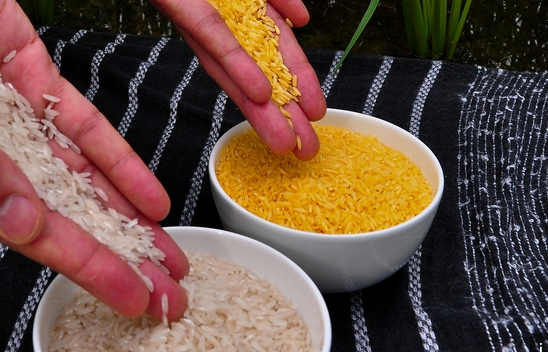The 5th Training Class of Genetically Modified Technology for Medias and Journalists in
China was hold in Changchun on 5th September, during which, Wan
Jianmin, academician of Chinese Academy of Engineering (CAE), introduced the
progress of some major special projects, and he also disclosed, at the same
time, that the genetically modified herbicide-resistant soybean and genetically
modified insect-resistant corn were the most possible two that would be firstly
industrialized in China during the next five years. According to Lin Xiangming,
head of Gene Transfer and Bio-safety Intellectual Property Department of Ministry
of Agriculture, China is currently promoting the transfer from the qualitative
identification to quantitative identification on genetically modified food.

Source: Bing
Generally
speaking, according to Wan, China now ranks the second around the world in
terms of genetically modified technology system (including technology and
breeding), next to that in the US while superior than that in Japan, Germany,
and the UK.
According to the National Scientific and Technological
Innovation Project of the 13th Five-Year Plan issued by the
State Council on 8th August, 2016, we have to promote the
industrialization of the newly developed insect-resistant cotton,
insect-resistant corn, and herbicide-resistant soybean during the period of the
13th Five-Year Plan. The Training Class, with the theme of “understanding
China’s genetically modified corn”, aimed to make media and public to know more
about the demand and ability of industrialization of China’s genetically
modified products through discussion and communication.
Progress has achieved on the Major Special Projects
China established “Major
Special Project for GM Products” in 2008, with 15 years of planned due time and
RMB 24 billion of expenditure (RMB 12 billion of which would come from the
federal government).
During the
meeting, Wan disclosed the progress of the major special projects in detail. Both
the animals and plants have been involved in, and more specifically, rice,
wheat, corn, soybean, cotton, pig, cattle and sheep were the emphases of the
project. In the field of the genetically modified agriculture about which
people concerned most, currently there are 124 breeds have been in examine and
6 safety certificates were issued, including genetically modified
insect-resistant cotton, genetically modified-resistant rice, genetically
modified phytase corn and genetically modified papaya.
All of the 124
certified varieties were genetically modified insect-resistant cotton. In 2008
to 2015, the genetically modified cotton was popularized and accumulatively
cultivated in about 26.66 million ha, taken up 95% of the domestic market
share, reduced 400 thousand tonnes of pesticide, and created economic value of
RMB45 billion.
According to Wan,
there have already developed many new varieties of genetically modified cotton.
For example, greensickness-resistant cotton that has developed recently and so
does quality-improved genetically modified cotton. In the future, China would
also be capable of producing the cotton that as high-quality as that of the US
and Australia and thus would get rid of the dependence on import.
According to Safety Regulations of Agricultural
Genetically Modified Organisms (GMOs), there should be three phases in agricultural
GMOs test: pilot experiment, environmental release, and production experiment. That
means, only if the production experiment has passed, can it possible to get a
safety certificate, after receiving the safety certificate, it is time to go
through the variety certification, and the industrialization can be achieved
after all those procedures have competed step by step. In China, the genetically
modified cotton and pawpaw have already been industrialized and commercialized
in 1990s, while the genetically modified insect-resistant rice and genetically
modified phytase corn have not industrialized yet though the safety certificates
have already received. According to the National
Scientific and Technological Innovation Project, more varieties would
gradually get the safety certificates and then put into industrialization.
On the meeting,
when the journalist asked which variety is the most possible one to be applied
as a breach to achieve the commercialization in the future, Wan answered that genetically
modified herbicide-resistant soybean and insect-resistant corn would be the
mostly possible two to be approved to put into commercialized cultivation, as
these two varieties were in huge demand and have already got relatively mature
technology and international competitiveness.
China’s Research Progress on GMOs: Global Leader of
Rice, Enthusiastic Follower of the other Crops
Some conferees
wondered whether China got the core technology and patent in terms of GMOs.
According to Wan, China has already cloned 3,160 genes, among which 137 had
important breeding value. That is to say, China has got its own gene patents,
and the situation that the US and European countries may monopolize the gene
patents has greatly changed.
China advanced in
the field of rice functional genomics and gene cloning research, among 16
published NCS thesis from 2014 to 2015, 11 of which were written by Chinese
scientists. The researches on the functional gene of corn, wheat, soybean, and
cotton have also been in the forefront of the world.
Generally
speaking, China ranked the second in terms of genetically modified technology
system, next to than in the US but superior than that in Japan, Germany, and the
UK.
Major special
projects also involved some supporting work of detecting techniques, safety
evaluation, and various technical standards and regulation.
However, there are
several weak links in China’s genetically modified work, among which the most
prominent part were the incapability of intellectual property protection and
the huge gap between China and the US in terms of the amount of important gene
patents. Moreover, the low level of industrialization caused the divergence
between the research founding and market demand.

Promoting
Revise of “GMOs Labeling System”
Currently, China
carried out qualitative identification, which means as long as there’s genetically
modified ingredient in the food, there would be a GMOs label to adhere to.
However, many countries and areas implemented quantitative identification, that
is to say, only if the genetically modified ingredients in the food have
achieved a certain amount, there’s a need to label, for example, the standard
of Japan and Taiwan was 5%, South Korea was 3%, and European Union was 0.9%.
From Lin Xiangmin’s
point of view, it is unreasonable and unscientific to implement the qualitative
identification. Administration of Agriculture has all the way negotiated and
coordinated with the Office of Legislative Affairs of the State Council and
other departments, so as to promote the revise on the GMOs labeling system.
According to Lin,
trivial of genetically modified materials spread around from research units,
including universities, research and development institution, and some
enterprises. The difficulty of the supervision is that China has hundreds of
research units, while in the US, there were only six enterprises have been
approved to work on the breeding of GMOs. Moreover, in China, there were also
many people illegally purchase genetically modified seeds abroad for breeding
test.
The reasons for
the blow on the illegal genetically modified crops cultivation not only
concerned the safety issues, but involved the violation to the Seed Law, Patent
Law, and Safety Regulations of Agricultural Genetically Modified Organisms.
Superiority of China’s Industrialization lies in Localization
According to Zhang
Shiping, scientist of agricultural biotechnologies, China’s seeds enterprises
got very obvious disadvantages in terms of industrial layout and funding
compared with international transnational corporations. For example, the cost
budgeting of Syngenta used to amount to RMB20 million per day, while the
general budget of major special project of GMOs in China were only RMB20
billion in total for 15 years, which including the supporting funds from the
federal and local government.
However, China has
also got its own advantages, according to Zhang, we can localize the genetically
modified crops for China’s domestic market, for example, the corns that resist asiatic
corn borer and oriental armyworm, and thus our products can rapidly adapt China’s
agricultural environment.
According to
Zhang, it may be better for China’s enterprises to focus on researching and
developing a few of advantaged industries, for example, the corn and soybean. And
China would also get its own super agricultural enterprises when we’re in an
environment with open policies and social support.
*The
article is edited and translated by CCM. The original one comes from Guanca.cn.
About CCM:
CCM is the leading market intelligence
provider for China’s agriculture, chemicals, food & ingredients and life
science markets. Founded in 2001, CCM offers a range of data and content solutions, from price
and trade data to industry newsletters and customized market research reports. Our clients include Monsanto, DuPont, Shell, Bayer, and Syngenta. CCM is a
brand of Kcomber Inc.
For
more information about CCM, please visit www.cnchemicals.com or
get in touch with us directly by emailing econtact@cnchemicals.com or
calling +86-20-37616606.